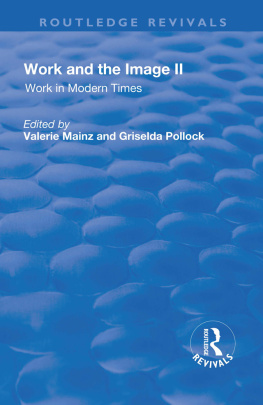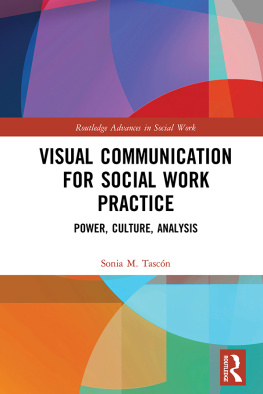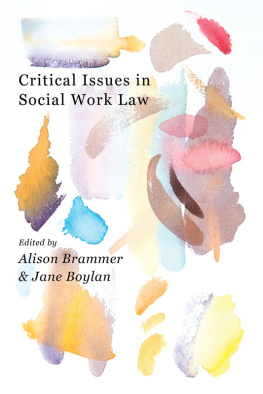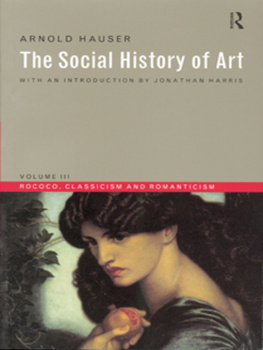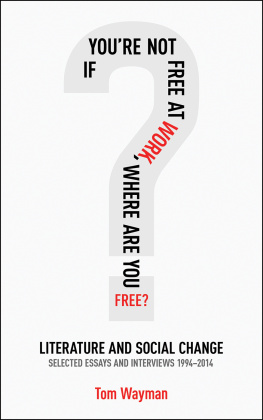WORK AND THE IMAGE II
Work and the Image I
Work, Craft and Labour
Visual Representations in Changing Histories
Edited by Valerie Mainz and Griselda Pollock
Introduction
Valerie Mainz and Griselda Pollock
A Greek vase-painting
Comments on the nature of craftsmanship?
Michael Duigan
Aux armes et aux arts!
Blacksmiths at the National Convention
Valerie Mainz
'The cook, the thief, his wife and her lover'
LaVille-Leroulx's Portrait de Ngresse and the signs of misrecognition
Helen Weston
Death and the worker
Rethel in 1849
William Vaughan
Gender and the ideology of capitalism
William Bell Scott's Iron and Coal
Jane Garnett
Time and work-discipline in Pissarro
T.J. Clark
Mihly Bir's Npszava poster and the emergence of Tendenzkunst
Sherwin Simmons
A re-vision of Ukrainian identity
Images of labouring peasant women in Tatiana Yablonskaia's Corn, 1949
Pat Simpson
Life and work in Silesia according to Kazimierz Kutz
Ewa Mazierska
This time next year we'll be farting through silk
Aspiration and experience
Anonymous
Work and the Image II
Work in Modern Times
Visual Mediations and Social Processes
Edited by Valerie Mainz and Griselda Pollock
First published 2000 by Ashgate Publishing
Reissued 2018 by Routledge
2 Park Square, Milton Park, Abingdon, Oxon OX14 4RN
711 Third Avenue, New York, NY 10017, USA
Routledge is an imprint of the Taylor & Francis Group, an informa business
Copyright The individual contributors, 2000
The authors have asserted their right under the Copyright, Designs and Patents Act, 1988, to be identified as the authors of this work.
All rights reserved. No part of this book may be reprinted or reproduced or utilised in any form or by any electronic, mechanical, or other means, now known or hereafter invented, including photocopying and recording, or in any information storage or retrieval system, without permission in writing from the publishers.
Notice:
Product or corporate names may be trademarks or registered trademarks, and are used only for identification and explanation without intent to infringe.
Publishers Note
The publisher has gone to great lengths to ensure the quality of this reprint but points out that some imperfections in the original copies may be apparent.
Disclaimer
The publisher has made every effort to trace copyright holders and welcomes correspondence from those they have been unable to contact.
Typeset in Palatino by Manton Typesetters, Louth, Lincolnshire, UK.
A Library of Congress record exists under LC control number: 00040610
ISBN 13: 978-1-138-73046-5 (hbk)
ISBN 13: 978-1-315-18942-0 (ebk)
NANCY BARTON is an artist and educator who directs the Undergraduate Program in Studio Art at New York University. Her work has been exhibited widely at venues including MOMA New York, Long Beach Museum of Art, American Fine Arts, Shoshana Wayne and Christopher Grimes galleries.
ELIZABETH COWIE is Reader in Film Studies in the School of Drama, Film and Visual Arts at the University of Kent, Canterbury, and one of the founding editors, in 1978, of the feminist theory journal, m/f. She has published Representing the Woman: Cinema and Psychoanalysis (1997), and edited, with Parveen Adams, The Woman in Question: m/f (1990). She has also published on film noir and on the documentary film.
MARTIN IGNATIUS GAUGHAN is Subject Leader in the History and Theory of Art, University of Wales Institute, Cardiff. He is presently co-editing a volume on 'New York Dada' in the series 'Crisis and The Arts: The History of Dada', and has contributed two chapters to earlier volumes in the series.
ANNIE GRIN is Assistant Professor in the Department of Visual Arts at the University of Regina, Saskatchewan, Canada. She was educated in the fields of Russian Studies and Art History in Canada, Russia and England. She is now working on legitimation strategies in Soviet monumental art and material culture.
KRISTINA HUNEAULT is engaged in continuing research on the representation of women workers in British and Canadian visual culture. She has published on the subject in the Journal of Canadian Art History and RACAR ( Revue d'art Canadien/Canadian Art Review). Dr Huneault teaches at Concordia University in Montreal, Canada.
VALERIE MAINZ is a Lecturer in Art History and Jewish Studies at the University of Leeds. She curated the exhibition Vintage du Travail et la Revolution franaise for the Muse de la Rvolution franaise in Vizille, France, and has published widely on visual representation in the revolutionary period.
CLAUDINE MITCHELL is Associate Lecturer at the University of Leeds. She was elected the first Henry Moore Scholar there. She is the author of On the Representation of Time (1985) and On the Brink? (1992). She is a contributor to Reflections of Revolution (1993), The Dictionary of Women Artists (1997), and the journals Art History, The Feminist Review, Sculp' Age and The Oxford Art Journal. Her book on Rodin is in preparation.
GRISELDA POLLOCK is Professor of Social and Cultural Histories of Art at the University of Leeds. She has published extensively on issues of class and gender in visual representation and on contemporary visual art, cinema and feminist cultural theory. Her latest book is Differencing the Canon: Feminist Desire and the Writing of Art's Histories (1999).
MO PRICE lectures in History of Art and Design at Birkbeck College, University of London, and in the Department of Visual Arts, Goldsmiths College, London.
VIVIAN REHBERG specializes in painting and politics in twentieth-century Europe, and is particularly interested in questions of figuration, tradition, temporality and historicism. She lives and works in Paris.
JOHN C. WELCHMAN is Professor of Modern and Contemporary Art at the University of California, San Diego. He is author of Invisible Colors (1997), Modernism: Relocated (1995) and Art after Appropriation (2000), and editor of Rethinking Borders (1996). His 'Survey' of the work of Mike Kelley was published in Phaidon's 'Contemporary Artists' series, 1999.
Introduction: trauma and subjectivity in work and worklessness
1 'Living tableaux of misery and oppression': sweated labour on tour
2 Facing horror: women's work, sculptural practice and the Great War
3 Colour, light and labour: Futurism and the dissolution of work
4 The missing mcanicienne : gender, production and order in Lger's machine aesthetic
5 'A progressive dematerialisation of labour power': a problem for visual representation in Germany in the 1920s
6 From cyborg to state worker: figures as/in technology
7 Realism and ideology in Andr Fougeron's Le Pays des Mines
9 The pathos of the political: documentary, subjectivity and a forgotten moment of feminist avant-garde poetics in four films from the 1970s
10 Teletales from the crypt
Valerie Mainz and Griselda Pollock
Our stern and chilling subject is work, the real and symbolic site of exploitation, political resistance, as well as of social identity and self-definition. Work is also the context of complex formations of class and gender, sexuality and social discipline. In contemporary cultural analysis or studies in art history and visual culture, work competes with the more popular and 'sexy' themes indicative of our changing concerns and preoccupations. Sexuality, Pleasure, Identity, the Body are current objects of widespread analysis in ways that are shaped by the post-structuralist attentiveness to many vital areas that fell below the theoretical threshold of the major modernist theorizations of culture, society, ideology and history in which work featured so centrally, notably Marxism. At this historical moment, however, when the possession of a credit card seems more critical to social participation and recognition than a stake in relations of production, and when most forms of labour, artistic and academic included, are dissipated into the commodified gloss of entertainment, behind which lies the global intensification of proletarianization and commodification, it seems provocative and important to turn our attention in historical retrospect to a dimension of social relations and economic processes as well as of symbolic meaning and structures of identity, to work, that having once been so cogent and predominant in social experience, political organization, communal life and theoretical paradigm, has ceased to be the focus of cutting-edge analysis.

